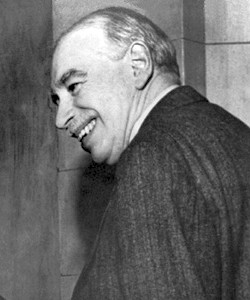John Maynard Keynes was a British economist whose school of thought became known as Keynesian economics. His belief that government could and should influence the economy to flatten business cycles revolutionized economic theory.
John Maynard Keynes is one of history’s most influential economists. He lived from 1883 to 1946 and witnessed the hyperinflation of Germany following WWI and the Great Depression in the early 1930s. He believed that the government should manage the economy through fiscal and monetary policy to avoid wild fluctuations in business cycles. His economic ideas continue to be touted by economists and politicians. However, at no time did he have a greater impact on the economy than during the Great Depression when President Franklin Roosevelt embraced his ideas with the New Deal.
Adam Smith, David Ricardo, and Alfred Marshall were classical economists who preceded John Maynard Keynes. They were proponents of laissez-faire economics. Laissez-faire is commonly used to describe a free market with minimal government interference, and businesses are left alone. Business cycles are self-correcting because prices are flexible. Classical theory predicts that workers accept lower wages during downturns but remain employed. When times are prosperous, workers demand higher wages. The factors of production constrain output, which remains constant even when there is a drop in aggregate demand. Therefore the price level is solely a function of an economy’s aggregate demand. Classical economists recommend patience during recessions because, eventually, the economy will recover. Classical economists fear that massive government spending does more harm than good by adding too much to the national debt.
The Great Depression tested everyone’s patience. The unemployment rate in the United States climbed to 25 percent. Many businesses failed. Prices were falling, but there was no sign of the economy self-correcting. Keynes believed that in the long run, the economy would self-correct, but he said, “In the long run, we are all dead.” He thought the government should kick-start the economy and that the Depression could be shortened by increasing government spending, even if it meant going into debt. The objective was to directly stimulate the demand for goods and services by hiring companies and individuals to provide various goods and services. President Roosevelt adopted Keynes’s theory when implementing the New Deal, which employed thousands of workers to start many government programs. Using borrowed money, the Works Project Administration hired many unemployed people to build public structures such as schools, parks, and bridges. These newly employed workers soon began purchasing goods and services from other businesses in their communities. These businesses, in turn, hired more people, which increased the economy’s aggregate demand. The Great Depression remained stubborn, but government spending to hire soldiers and purchase military equipment ultimately increased the aggregate demand and pulled the US out of the Depression. Keynesian ideas continue to influence economists and economic policies.
 Wiki Commons - By IMF - File:WhiteandKeynes.jpg - Crop of the original picture IMF Public Domain
Wiki Commons - By IMF - File:WhiteandKeynes.jpg - Crop of the original picture IMF Public Domain
Critics point to how Keynes’s theory has resulted in a widespread belief that government, rather than the free market, should resolve our problems. They warn that Keynesians micromanage the economy resulting in government decisions being made by intellectuals rather than the consensus of the marketplace. People in power are slow to increase taxes or decrease spending during boom times, resulting in mounting national debt. Furthermore, these decision-makers are slow to recognize that every decision has a cost. A tax increase deprives taxpayers of the ability to buy some items. Government purchases allocate capital where it may not be the most efficient. In fact, it may crowd out private investment by pushing up interest rates.
Fiscal Policy – Managing an Economy by Taxing and Spending
Monetary Policy – The Power of an Interest Rate
Business Cycles
The Federal Budget and Managing The National Debt